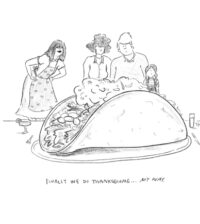Is the new Sonoma Valley Unified School District’s dress code just a Band-Aid? Does it punish the innocent? Unfairly target Latinos? Is it an inconvenient stop gap that gangs – whose intimidation of others is the reason for the code – will simply work around? Or is the code a safety measure that gives students a sense of relief? And, if it actually does reduce violence – as several teachers and administrators have indicated seems so far to be the case – can the underlying problems be addressed?
Wednesday, Oct. 22 at a workshop put on by the Sonoma Valley Unified School District, trustees, school administrators, teachers, student representatives, community leaders, law enforcement officials, parents and a few small children filled the Sonoma Valley High School library to discuss the dress code and the issues surrounding it.
Some parents began with questions about drugs on campus, but board president Cam Hawing suggested that topic should be saved for another workshop. He focused the discussion on the dress code, the rationale behind it, and the problem it’s designed to solve. “I believe at this point, the school is at the level of just being preventive,” he said. “All of our sites are safe. But we want to make it safer.” He invited comments and the hands that flew up were so many, he had to write down names and limit the time, so that everyone had a chance to speak. “We need these ideas, these opinions and start thinking about these alternatives,” he said, and to those who did not get a chance to speak, he suggested they send e-mails.
After a brief discussion about the code itself, and whether the gangs would simply get around it and use other signals for their intimidation activities, Micaela Philpot, principal of Sonoma Valley High School, said that from her observation, the campus is quieter now. “Since we’ve changed the dress code we have seen changes in student behavior,” she said. “Kids are talking among themselves. It is less intimidating than when you see groups of kids wearing red, groups wearing blue.”
Sydney Smith, principal of Altimira Middle School, said she, too, has seen an improvement, so far. “I’ve actually observed students in the teen center socializing together. The level of intimidation has dropped significantly.” She said that even though gang members might use other, more subtle indications, like shoelaces or bandanas, eliminating the solid reds and blues works because “all the students recognize the significance of red and blue.”
Trustee Nicole Abate Ducarroz agreed that something seems to be working. “This past month was the least amount of expulsions and suspensions than I’ve seen going into my fifth year here.” David Pier, executive director of the Boys and Girls Clubs of Sonoma Valley, said, “I think the dress code is not a solution, but is part of the school’s ability to address the problem they see on the campus.”
One questioner suggested that the code may be geared to target or ostracize Latino students, as gang members tend to be of the Latino population. Why, another wondered, couldn’t there be uniforms, as many Latino parents favor. Another, also concerned about the Latino students, asked what happens to students who are expelled. Trustee Helen Marsh stated clearly that no one has been suspended or expelled for violating the dress code. But, she acknowledged, if they do commit an infraction that triggers expulsion, they are on their own. “If they’re expelled, it’s their obligation to find another school,” she said. “This board has focused on what do we do with kids before they get to that point.” As to uniforms, she asked, “To what extent do people feel uniforms would be helpful?” A show of hands revealed many did. One speaker said many Latino parents were in favor of uniforms, but many couldn’t afford them. A Latina student said the good thing about uniforms is that it helps ward off the “gang stuff” and the urging to wear red or blue to be accepted. “You’re pressured,” she said.
Sgt. Carlos Basurto, of Sonoma County Sheriff’s Dept.’s Multi Agency “GaNg” Enforcement Team (M.A.G.N.E.T) said it’s important to understand the gang mentality. “The reasons gang members wear colors are; one, to identify – this is who I am, this is what I do. The biggest reason is for intimidation, that’s why they wear their colors. To intimidate not only the community, but their rival gang. It gives them the status in that community that they’re looking for. Power. Friendship. Peer pressure. The gang who is not feared in the community might as well be a baseball team.”
A Latina woman who said she’d grown up in Los Angeles in gang territory said, “What it comes down to is Latinos. Latinos are the ones in the gangs. Do we see positive roles for Latinos? It’s really hard to say, how are we going to address this when we have 45 percent of our community being Latino, and when I talk to parents, they don’t feel part of the community. I’m here to help with different ideas on how nonprofits can help. What programs do we have in place for after school to help kids feel part of the community?”
Pier addressed prevention and the wider issue. “Gangs are really a community issue,” he said. “And as a community there have to be many avenues to help kids.” His work, he said, is on the prevention side. “If they’re already in gangs, it’s very difficult to intervene. [But] there are good things happening.” He said he’d worked at a school that forbade red and blue and all sports memorabilia, “and it was easier.”
Kathy Witkowicki, executive director of Stand By Me Mentoring Alliance, said at first she thought the dress code was empowering gangs. Now she sees it as a safety issue. She acknowledged the importance of cultural inclusion for Latinos and stressed that the earlier it happens, the better. “We’re always, always looking to recruit Latino and Latina mentors for our mentees. We did a huge outreach. And for whatever reasons, I’m having a hard time.”
Someone mentioned the need for family support, noting that is more difficult with the Latino population. Suddenly, a low-voiced murmur that had been going on at the back of the room throughout the entire session ceased. From where the sound came from, a hand shot up and a small, Latina woman stood and began an impassioned speech in rapid-fire Spanish. Seated beside her was Ashley Halliday, SVUSD Director of Human Resources, who had been translating the entire proceedings for her into Spanish. For several moments, as the woman spoke, the group blinked in surprise. Then a Latina member of the audience called out to the speaker to wait, slow down, and began translating for the rest.
“She says she hears people say Latinos are not interested in kids,” the helpful neighbor said. “She says she comes to all her kid’s classes and her kid says, ‘Why do you come? You don’t understand anything.’ But she says she’s really interested in the kid’s education. She says she’s very grateful for the dress code, because it will lessen the problems in the school. She says her daughter is in Flowery, where there are 50 Latino parents and two Anglo. She says it’s important to find solutions.” Graciela Contreras, who speaks no English, but who got her message clearly across, then sat down.
Hawing picked up the cue and said a few words in Spanish and then in English. Pam Garramone, principal of the Sonoma Valley Adult School noted how many parents there were – at that moment – in class learning English. Trustee Dan Gustafson said, “We’re all in this county together. We’re all in the schools together. We’re in the streets together. I’m sensitive to the big elephant in the room, but it’s not them – it’s us.”
Melanie Blake, a teacher at the high school, after expressing her unresolved frustration at the sudden imposition of the dress code and requesting that teachers be included in important decisions, told a story about a 17-year-old Latino boy who sat in her class, crying. He said he’s been in gangs, is on probation, can’t drive, wants to do his homework but his family can’t afford Internet. “We’re trying to do triage,” said Blake. “We understand there are so many problems. But your teachers are your front lines. We’re the ones trying to help them get to school, how to pass state tests, and how to get to college. This young man just wants to know how to find a way back. I need to find a way to say to this young man, ‘Your gang activity is not welcome, but you, you can come in.’”
Of red and blue: colors of division, talk of unity
More from What's HappeningMore posts in What's Happening »
- Cartoon by Hillary: “Finally We Do Thanksgiving…My Way”
- Permit Sonoma Recommends Decertification of the SDC Specific Plan Environmental Report and Abandoning the SDC Specific Plan
- Chinook Salmon Spotted in Valley Creeks
- Lighted Tractor Parade Set for November 30 on Sonoma Plaza
- Creative Sonoma Announces #TeachTheArts Campaign to Boost Local Teaching Workforce
- The Living Legacy of Mac McQuown






